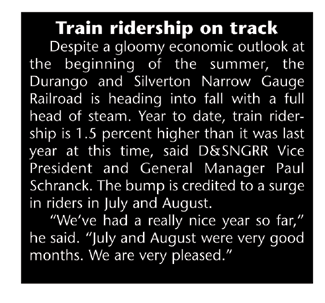|
| ||||
| Smoke signals SideStory: The smoke sale: Task Force hosts yard sale fund-raiser
by Missy Votel Halfway into its five-year commitment to clean up emissions, the Durango and Silverton Narrow Gauge Railroad is on track. Fueled by a recent grant of $44,000, the train announced plans last week to design an expanded, more energy-efficient scrubber system. The grant was secured by the Train Smoke Mitigation Task Force, a consortium of South Durango residents and civic, city and railroad representatives. Half of the funds came from the federal Economic Development Administration with the matching $22,000 being split evenly among the City of Durango, La Plata County and the D&SNG. The money will be administered by the Region 9 Economic Development District. “The idea for the new scrubber system came out of a 2007 feasibility study on how the train could cut emissions,” said Laura Lewis, of Region 9. “So far, the train’s been crossing the recommendations off the list one by one. It’s been great.” The new scrubber system will be designed by local engineer Steve Marple, with input from train staff. One idea being explored is to install scrubber hoods over each train smokestack in order to more efficiently capture pollutants. The antique coal-fired engines must remain stoked and on “hot standby” overnight in order to facilitate start-up in the morning. However, that process,along with switching the trains at night and dumping spent ashes into an outdoor ash pile, have long been a source of smoky emissions, particularly over the southside neighborhood. Although the original scrubber system, installed in 2001, works, there is room for improvement, said train Vice President and General Manager Paul Schranck. “The first scrubber system worked pretty well, but it could be better,” he said. For starters, the current scrubber system is mounted on the roof of the roundhouse, where it sucks dirty air from the roundhouse and removes pollutants. In addition to requiring a large amount of energy to operate, the system also acts as a vacuum in the wintertime, literally sucking the heat out through the roof. By building scrubber “hoods” over the individual engines, the train would save on both heating and electrical costs while pinpointing the source of emissions. In addition to new scrubbers inside, the train is also looking at installing an outdoor scrubber over the ash pit. “That’s one area we may be able to improve,” he said. The Train Smoke Task Force formed in 2006 with the goal of helping the train reduce emissions. In 2007, train owner Al Harper announced a five-year “Smoke Reduction Plan,” including $50,000 a year in cash as well as $50,000 of in-kind labor. The five-year plan also called for a cash commitment of $550,000 in 2010, contingent on paying off the loan for the original scrubbers. “From the beginning, Al and Karen (Harper) said they wanted to be good citizens and good neighbors,” said Schranck, adding that the only requirement was the fixes be in keeping with the train’s historic nature. “If there are things we can do that don’t take away from that, we will try our best.” Out of the Task Force’s 2007 recommendations, several have already been implemented such as: • Burning wood pellets instead of coal at night to keep engines warm.
• Burning wood pellets instead of coal at night to keep engines warm. • Using diesel locomotives for switching trains and performing track maintenance at the Durango station. • Giving all engine firemen specialized training on how to place coal and wood pellets into coal box to reduce smoke and facilitate cleaner burning. • Purchasing green power through La Plata Electric Association and planting 2,587 trees in Durango and Silverton to offset vehicle fleet emissions. Southside resident and original task force member Sarah Wright said thus far the plan has been paying off, with less smoke. “It’s much, much better than when we first started,” she said of the train’s efforts. “I really am impressed with what the train’s done for us.” She also credited the hard work of all the members of the Task Force in trying to come up with solutions. “The group has really been brainstorming and doing what they can,” said Wright. “It’s exciting that the train is helping. It’s a very enthusiastic group.” Schranck said the enthusiasm extends beyond the Task Force meetings. “I’m very proud of our people. Everyone has been really positive and worked hard at finding solutions,” he said Despite the spirit of collaboration, the train still has a ways to go before reaching the end of the line. “We went into this thinking it would be a five to 10-year plan, so we’re on track,” said Wright, adding that the train is still open to, and even encourages, comments on air quality from residents. “It’s really helpful if it’s been a bad night for residents to e-mail the train,” she said. “Sometimes they’re not even aware there’s a problem or an equipment malfunction.” Schranck said he looks forward to seeing what the scrubber engineer comes up with, but implementing the plan will be a different story. Without an actual design in place, he said it’s hard to even conjecture on a price for the new system, but he is optimistic about the momentum behind the project. “There’s lots of good stuff continuing to go on,” said Schranck. “The whole thing is working out pretty great.” •
|



